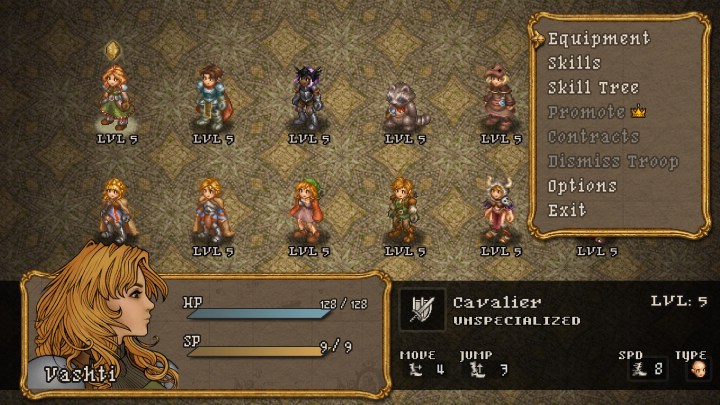I recently fished my family’s old PlayStation 3 Slim from my dad’s bedroom, set it up in front of my TV, and promptly sampled a smorgasbord of classic PlayStation-era JRPGs from the halcyon days of my childhood. I scampered through Legend of Legaia, Wild Arms 2, Legend of Dragoon, Lunar: Silver Star Story Complete, but wait … where was my copy of Final Fantasy Tactics? Absolute horror washed over me as I realized the greatest jewel of my childhood legacy was misplaced or potentially gone for good, like Gollum mourning the loss of his precious ring. But hey, at least the stylistically similar Arcadian Atlas is set to release next year, meaning the Final Fantasy FOMO is less potent than it would be otherwise.
If this is the first you’re hearing of it, Arcadian Atlas is a tactical RPG by Austin, Texas-based developer Twin Otter Studios that commits to its obvious Final Fantasy Tactics roots. When I demoed the game at PAX West, it immediately brought me back to my youth with a tribute to Final Fantasy Tactics’ 16-bit visual style, rich turn-based tactical combat, and a party management system so seemingly robust that I can’t wait to get my hands on it when it releases.
Up to 30 hours of tactical goodness
Arcadian Atlas features a familiar 16-bit-inspired visual style and an intuitive tactical combat system wherein your party can move around the map to gain specific advantages, bending the flow of battle in your favor. Cleverly positioning your troops around the map can completely change how they match up against your opponents, and since you can only move so many tiles per turn, strategy is a majorly important element in Arcadian Atlas. Fans of the genre will already know what they’re in for, but for what it’s worth, each character gets to move and then use an action every turn, making it important to choose your steps wisely.
Filling up around 30 hours, Arcadian Atlas‘ story-centric campaign seems cute rather than serious, and it’s yet to be seen if it’ll climb the philosophical heights of its forebear. In the introductory sequence leading up to the first of the two battles showcased in my demo, I watched a raccoon get alchemically shape-shifted into a spellcasting raccoon humanoid named Poncho. I appreciated the playfulness of this moment versus, say, Final Fantasy’s Ramza giving a Shakespearian monologue about death and freedom. I was offered the chance to execute a character during a story sequence, though it’s hard to tell how important Arcadian Atlas’ binary choices will ultimately be — at least not without a closer look.
Warfare with class
Arcadian Atlas’ isometric maps make pretty interesting use of verticality. One battle situated me (rather, my party of up to five troops handpicked from a much larger roster) against a group of bandits occupying a wizard’s laboratory surrounded by some mountainous cliffs. I immediately sent my archer to the top of the cliffs and poured arrows down on the bandits below, drawing their ire away from the rest of my party, including the unexpectedly useful Poncho. I took issue with how easy it was for enemy ranged attackers to target my archer from the ground, though I certainly gave my melee opponents a run for their money. Adding a little salt to the wound, however, I wasn’t even sure what my archer’s other abilities did … and this inadvertently set them up for failure when I mistakenly used an attack that would take two turns to fully wind up.
Arcadian Atlas features a robust class system with 12 classes — including the warrior-like Cavaliers, mage-like Warmancers, Apothecaries who can throw potions like grenades or healing flasks, Field Medics that do exactly what their name suggests, and so forth. Each class is supposedly pretty customizable down the line, though I didn’t get to test out any deeper character customization during my playthrough. It’s also possible for characters in your roster to permanently die, which is exactly what happened to my archer by the end of the aforementioned battle.
There’s a lot of promise here for TRPG fans and possibly even JRPG fans. Of course, it isn’t the only newish game in the tactical RPG genre. There’s the whole Fire Emblem series (which I’ve never touched at any point in my life), and upcoming games like Lost Eidolons may scratch that same Final Fantasy Tactics itch when it releases next month. The key selling point for Arcadian Atlas, however, may just be its adherence to the familiar. Though its story hasn’t had the chance to breathe after just one hour, it did get a few chuckles out of me and ultimately felt quaint enough to carry a game that knows it’s riffing on my nostalgia for Final Fantasy Tactics.
Arcadian Atlas is still a ways away, considering its slated release window of summer 2023. But it may very well be worth that wait when it finally releases on PC and Mac.






